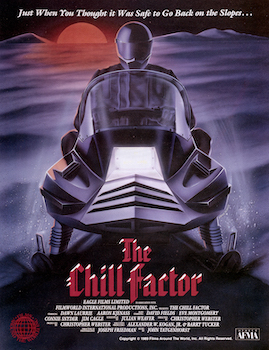The 1993 film, The Chill Factor, is a bit of an oddity.
The film opens with a shot of young, attractive people racing their snowmobiles across a snowy landscape. One of them, Jeannie (Dawn Laurrie), narrates. She tells us that she can still remember everything that happened as if it was yesterday. She and her friends were visiting the ski slopes of Wisconsin. She was engaged to be married to Tom (Aaron Kjenaas), who she secretly knew didn’t really love her that way that she loved him. She mentions that they were traveling with their friends and none of them had any worries because they were young and the year 2000 was right around the corner. She mentions that one of her friends was “dating a black girl.” It’s an odd line, especially when heard in 2023, when interracial couples in movies and television are so common that it’s almost become a bit of a cliché. One thing that makes the line feel all the stranger is the rather flat tone of the narrator’s voice. The narration almost sounds as if it’s being delivered by someone who is under hypnosis.
Jeannie, Tom, and their friends stop off at a rustic lodge. Karen (Connie Snyder) is Tom’s little sister and Chris (David Fields) is her boyfriend, as well as being a medical student. Ron (Jim Cagle) is a friendly football player who has just been drafted by a pro team. Ron’s girlfriend, Lissa (Eve Montgomery), is the black girl mentioned in Jeannie’s opening narration. When two local racists confront Ron and Lissa and spit out a racial slur, friendly waitress Bessie (Bekki Vallin) makes it up to the group by telling them about a great place to race their snowmobiles. It’s called Black Friar Lake and Bessie promises to tell them why it’s named that if they come back. Even though Tom has been drinking all day long, he insists on going out to Black Friar Lake.
At Black Friar Lake, Tom pulls a Kennedy and crashes his snowmobile into a tree. His friends drag the unconscious and blood-covered Tom to an abandoned Dominican summer camp. They bandage his wounds and try to keep him warm. Chris says that Tom probably has internal injuries. However, Tom suddenly opens his eyes and, other than having a headache, he acts as if nothing serious has happened. While Ron heads back to town to try to get help, Karen searches the camp and comes across a makeshift Ouija board. Even though Jeannie believes that Ouija boards can actually summon evil spirits, she still joins the others in fooling around with it. (As Jeannie explains in her narration, “It was my nature.”) Soon, Tom is waking up more often and speaking much more aggressively than usual. (When Karen — HIS SISTER — tells him that he’s a pain in the ass, Tom tells her, “I’ll give you a pain in the ass,” and then suggests that she and Chris should go have sex.) Soon, people are dying, blood is being spilled, and the Ouija board keeps trying to send out messages.
The Chill Factor is an odd film. On the surface, it seems like a typical mash-up of slasher mayhem and Evil Dead-style supernatural activity. But there’s an intriguingly off-center quality to the film. The film moves at its own dream-like pace, with certain scenes going on longer than one might expect while other scenes end rather abruptly. When the group first arrives at the summer camp, their conversations are a bizarre mix of the mundane and the philosophical. Random shadows can be spied moving along the walls and the main characters never seem to notice that fresh blood is flowing from the eyes of a statue of Jesus. Towards the end of the film, there’s a Rosemary’s Baby-style sex scene between Tom and Jeannie, except occasionally it’s not Jeannie that Tom is making lover to but instead Karen. The falling snow gives the entire film a chilly and rather bleak atmosphere. (This may be the only film to feature a demon chasing his prey on a snowmobile.) The cast was obviously made up of amateurs and the majority of the performances are extremely stiff. However, even that contributes to the film’s otherworldly atmosphere. Indeed, watching the performers, I was reminded of Werner Herzog’s Heart of Glass, in which Herzog had his actors perform under the influence of hypnosis.
Finally, there’s an interesting subtext to this film. Jeannie, who fears that Tom will never love her the way that she loves him, has a night of passionate sex with him, just to wake up the next morning and discover that he had suddenly changed. He’s not the man who she thought he was. Now, in Tom’s case, this is because he’s been possessed by a demon. However, this scene captures a fear that every woman has felt. Will your lover still be the same man when you wake up in the morning? Or, having gotten what he wanted, will he then reveal his true self? As much as Jeannie feared the Ouija board, she still used it because, deep down, she wanted to know who Tom really was. And the board revealed the truth. In her final piece of narration, Jeannie speaks of still dreaming about that night with Tom and her flat tone leaves it up to the audience to decide if she dreams of who Tom become or who she thought Tom was before.
I suspect that The Chill Factor may have been a happy accident, a case of a low budget and an amateur cast actually coming together something that turned out to be far better than anyone was expecting. Accidentally or not, The Chill Factor is an intriguing work of existential horror.

Pingback: Lisa Marie’s Week In Review: 10/9/23 — 10/15/23 | Through the Shattered Lens